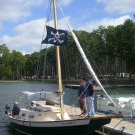
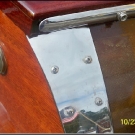
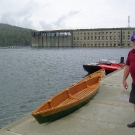



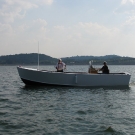
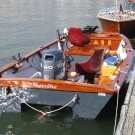
From time to time new boatbuilding methods are touted as a breakthrough in boat construction. We have by-passed many of these “breakthroughs” because we don’t believe in experimenting with your time and money. There have been several such methods of fiberglass construction that have proven to be less than advertised or not suited to the production of one boat.
Factory made fiberglass boats utilize a female mold with laminates made of sprayed resin and chopped glass fibers or, in more expensive boats, hand laid fiberglass and polyester resin. These methods are only suitable for volume production due to the high cost of the mold.
There are much better methods that make it practical to produce a single boat using fiberglass materials. Glen-L has done a great deal of research into the various options for “one-off” construction. This research has resulted in our 400 page book:FIBERGLASS BOATBUILDING FOR AMATEURS. It has also produced several designs which are detailed in our online catalog “Fiberglass Construction” section.
There are two types of “one-off” construction detailed in our plans: sandwich core and fiberglass planking (C-Flex). By using either of these methods you can produce a fiberglass boat that is equal to or exceeds the quality of factory-built boats. These materials are well within the abilities of the amateur, even those who have never built a boat before. The Glen-L methods are especially designed with you, the amateur, in mind.
In the photographs in our Fiberglass Boatbuilding Guide, we use the FOAMEE to illustrate the sandwich core construction method, and the FEATHER to illustrate the C-Flex method. These boats were designed to give you an introduction to these methods or as an end in themselves.
C-Flex Fiberglass Planking Manual
PLEASE NOTE: While we are enthusiastic about these “one-off” fiberglass methods, in order to be properly utilized, the boat must be specifically designed for the materials. We have designs which are especially adapted to these methods and have detailed them accordingly. We do NOT recommend taking our other designs with the intention of using one of these methods unless they are specifically intended for fiberglass construction. Our plans detail clearly the best method for building each particular boat. To protect your investment and have a boat you’ll be proud of, avoid improvising.
Glen,
What an inspiring story on your website and the boat “Midnight Cry”. I am part of a southern gospel quartet here in Ft. lauderdale Florida and we sing this great song. I am inspired by your love for our Lord and also your love for boat building as I grew up building boats for my family Merritt Sportfishing yachts here in Florida.
Hope we might talk one day
I’ve found an old 1965 glenn l boat that is full of rainwater. I am wondering if it would take alot of money to get it back on it’s sea legs. Do you have any diagrams of your 1965 models? It’s a motorboat, about 17′ long, with a very small cabin.
Thanks
Rory, all of our designs are in our online catalog but we don’t have a fiberglass motorboat with a cabin that is 17′ long. It’s possible the builder converted a plywood hull to fiberglass.
Oh, and it’s fiberglass.
Thank you to responding so quickly. It looks like I have a”bit” of reading to aabout how to construct a fibre glass boat’
Thank you again
Ron
I want to build a drift boat using one-off with foam board. Do you have plans available?
Dee, we don’t have any fiberglass drift boats–just the boats shown on our site: https://www.boatdesigns.com/Fiberglass-Construction/departments/6/
Thanks!
Do you know of any other people who have plans for a fiberglass drift boat?